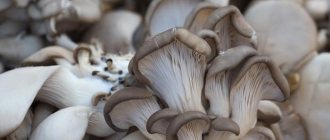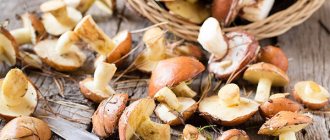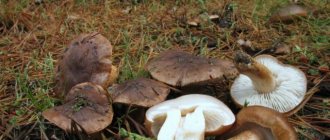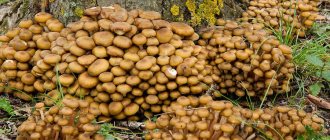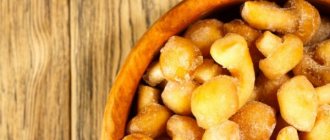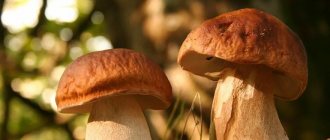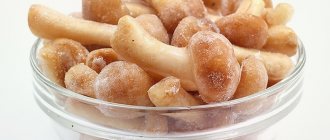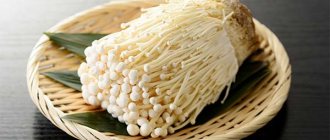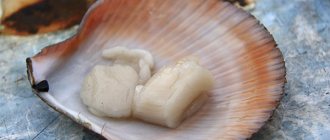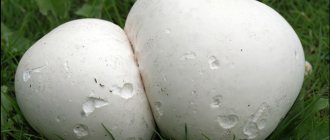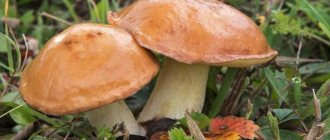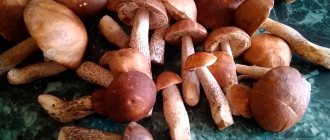Honey mushrooms are considered quite common mushrooms, from which various delicious dishes are prepared. They can be fried, salted, pickled, dried, etc. They grow in whole families, so you can immediately pick up a whole basket of mushrooms from one plot. For this reason, many mushroom pickers prefer to collect honey mushrooms. If several honey mushrooms are found in the forest, it means that somewhere nearby there is another whole group or friendly family of this species. It is rare for a fungus to grow alone. Honey mushrooms surprise with their diversity. They can confuse even an experienced mushroom picker when identifying the species.
What they look like and where they grow
These are lamellar mushrooms. Usually, mushroom pickers go to the forest in the fall to get real, true honey mushrooms. Their round caps can be seen from afar. Honey mushrooms grow near old, rotten trees, on rotten stumps, in the area of dead wood, and snags. But you can find representatives of the family in the meadow, under bushes, and on forest edges. The length of the leg of the honey mushroom is usually 12–13 cm. Some species have a fringe on the leg or, as many mushroom pickers call it, a skirt.
Appearance Features
True representatives can be distinguished by the following characteristics:
- They have a high leg, which has a kind of ring in the middle of the length or closer to the cap.
- The hat itself has a round shape, reminiscent of an umbrella.
- The surface of the mushroom cap is scaly.
- The color of the cap can vary from pale yellow to red.
- The plates located at the bottom of the mushroom cap are colored cream or pale yellowish.
Kinds
There are 34 known mushroom species of honey mushrooms, of which only 22 have been thoroughly studied. They are all somewhat similar to each other, but each species has its own characteristic features.
There are true honey mushrooms and fake (false), edible and inedible. In the article we will look at some representatives of the family in more detail and find out how you can distinguish a real honey mushroom from a “fake”.
Based on release dates and external characteristics, several of the most well-known species can be distinguished:
- autumn or true honey fungus;
- summer;
- thick-legged;
- winter;
- spring;
- northern;
- bulbous;
- shrinking;
- meadow;
- royal, etc.
Autumn
This species is called a true or real representative of the honey mushroom family. It is typically released in the fall. If the autumn is warm, then there is a chance to find mass families and reap a rich harvest. Both deciduous and coniferous thickets are suitable for this species. The fungus can be called indiscriminate, as it is capable of parasitizing in different places: not only near trees, but also in grass and near bushes.
It is not difficult to recognize, so even a novice mushroom picker can recognize it. The cap is painted in a pleasant yellowish color, reminiscent of a shade of honey, and can be pale orange or light brown. In the center the cap is darker. On its surface there are scales, which may disappear with age. The mushroom stem is long (8–10 cm).
The size of the cap of a young honey mushroom is small, its diameter is from 3 to 5 cm. The shape is convex, round, turning inward at the edges. The caps of mature mushrooms open and increase in size, their diameter can reach up to 10 cm or more.
The cap of honey mushrooms is dense, and its flesh is whitish in color. The mushroom smells nice. In an adult representative, the flesh of the cap becomes rough, almost unsuitable for food. It is better to avoid such mushrooms. Ripe specimens are not only tasteless, but can also be harmful to health.
The emergence of the autumn species is common in damp birch, aspen, coniferous and other forests. The beginning of growth is August, the end of growth occurs with the first frosts. The optimal temperature for this type of mushroom is +10°C.
Northern
It is practically no different from autumn. True, the mushroom has a more saturated color of the cap - light brown and looks stronger in appearance. The habitats are those of the first species.
Thick-legged
The name itself speaks for itself. The mushroom has a thick stem, compared to the autumn and northern species. It also has scales on the cap that are light in color. This species cannot be found in entire families. Thick-legged honey mushrooms grow in small groups.
The cap of the thick-footed species has a wide shape, lowered to the bottom along the edges. Its diameter is no more than 10 cm. The color of a young specimen varies - from light brown to dark. There are thick-legged honey mushrooms with pink caps. With age, the color darkens and becomes brown.
Young mushrooms always have a “skirt” on their legs, which disappears as they grow. Release starts in August and ends in September.
Bulbous
Quite a beautiful mushroom with a bright cap. The color of the cap is rich brown or bright yellow. In this species, scales are located on the entire surface of the mushroom. The legs have a tuberous shape. They can grow both on trees and on the ground.
The growth period is from early August to early October. The fungus prefers dead wood, old stumps, and rotten trees.
Shrinking
This is a ringless species (or, as it is also called, oak). He prefers deciduous trees. The leg does not have a characteristic feature - a ring, so it can be confused with deceitful representatives of honey mushrooms. Only experienced mushroom pickers can identify a real mushroom and collect it.
You can recognize the honey mushroom by other characteristic features: scales on the cap and the hairiness of the body, inherent in true representatives of honey mushrooms. The mushroom is collected from July. Collection ends in October.
Summer
This species does not belong to real honey mushrooms, but is very similar to it. It is edible, so we will tell you a little about it.
The mushroom cap is small, not exceeding 6 cm in diameter. The color is pale yellow. The main feature of this species is the presence of a tubercle. The surface of the cap is smooth, practically without scales. The leg is shorter than that of the autumn species.
The mushroom can be collected starting in April. This species bears fruit before the onset of cold weather.
Winter
This is also a false, but edible honey fungus. Outwardly, it is no different from the true representatives of the family; it prefers rotten trees and rotten stumps. It got its name from its ability to bear fruit even at low air temperatures. The release season is determined from autumn to early spring. But this does not mean that you can pick mushrooms in 40-degree frosts. In such cold weather it is in the stage of suspended animation, but with the onset of the first thaw it will instantly begin to come to life.
He is not picky in choosing places of growth. It can be found in the forest, in the garden, in the park, etc. For this reason, the winter species is successfully cultivated by the Japanese and Koreans.
Lugovoy
Also refers to false honey mushrooms. Very similar to true representatives of the family, the same color and the same shape of the cap. But there is no ring on the stem, and there are no scales on the cap.
The mushroom prefers meadows and open areas with grass. It can be collected from the beginning of summer until the end of autumn.
Royal
Classified as false honey mushrooms. It has a rather unique and effective appearance. Its entire body, including the leg, is covered with scales. It has a bell-shaped cap, prefers rotten forest stumps and trees, begins emerging in August, and ends in late autumn.
What is the difference between real honey mushrooms and false ones?
How to distinguish real representatives of the honey mushroom family from false ones? Let's consider the signs inherent in true honey mushrooms:
- They have a formation on the leg in the form of a ring, or as it is called, a “skirt”.
- They smell nice.
- Real honey mushrooms have caps that are always pale in color.
- The surface of the caps is covered with scales.
- The plates located under the cap are pale yellow, close to white, or creamy.
Video:
how to distinguish real honey mushrooms from false ones Expand
Appearance, where to collect
Honey mushrooms grow in entire families in the northern latitudes of the globe. They can often be found in grassy ravines, on stumps, old trees, and in damp or swampy areas.
- The size of the mushroom is about 12 cm, smaller specimens are more common.
- The leg is thin and long, light honey sometimes brown in color. Sometimes you can see a kind of “skirt” under the hat.
- The caps of young mushrooms are covered with small scales and are round in shape. As they grow older, the shape changes to umbrella-shaped and becomes smooth. The color of the hat varies from cream to reddish.
- The pulp is moist and smells like damp wood.
Composition and calorie content
Honey mushrooms are a low-calorie product. There are only 17 kcal per 100 g.
Worth knowing!
The main composition of mushrooms is water. Its content in honey mushrooms is 90%.
In addition to water, the mushroom contains:
- proteins;
- minerals;
- fiber;
- fats;
- alimentary fiber;
- carbohydrates;
- disaccharides;
- ash;
- monosaccharides.
Among the useful elements, it is worth highlighting amino acids, micro- and macroelements, and antioxidants. In particular, the composition of the mushroom includes:
- vitamins of group B, A, E, C;
- phosphorus;
- magnesium;
- sodium;
- potassium;
- iron;
- calcium and others.
Honey mushrooms marinated in Korean
Korean cuisine has been popular in Russia for many years. According to her recipes, not only vegetables and meat are marinated, but also mushrooms. Pickled honey mushrooms, photos of which are presented below, according to this recipe are moderately sour, with a piquant pungency.
First, peeled honey mushrooms (1 kg) are boiled for 10 minutes, then the broth is drained and again immersed in boiling water with the addition of 2 tablespoons of salt. At this time you need to prepare the marinade. To do this, add salt (1 teaspoon), sugar (2 tablespoons), crushed garlic (2 cloves), vinegar (3 tablespoons of a 6% solution) and red pepper (½ teaspoon) to a liter of boiling water. Let cool. Drain the mushrooms, boiled for 15 minutes, in a colander and then combine with the marinade. Place in a glass bowl in layers: onion cut into thin half rings - honey mushrooms - onion - honey mushrooms. Pour the marinade on top, put pressure on it and put it in the refrigerator for 8-12 hours. Bon appetit!
What are the benefits of honey mushrooms?
For women
Let us highlight the main points of the usefulness of mushrooms for the female body:
- The product is low-calorie, so you won’t gain extra pounds with it.
- Helps with diets and fasting days.
- Removes excess fat from the body.
- Normalizes the nervous system, helps with anxiety and insomnia.
- Promotes the formation of new cells due to its composition.
- Strengthens blood vessels.
- Has a beneficial effect on the condition of the skin, nails and hair.
- Removes toxins from the body.
- Helps with constipation.
- Prevents the development of malignant tumors, in particular mammary glands.
For men
Mushrooms can completely replace a full lunch or dinner, despite their low calorie content. Honey mushrooms are quite nutritious.
It is known that mushrooms of this family reduce cholesterol in the blood. They contain a sufficient amount of protein necessary for the stronger sex to maintain muscle tissue. Mushrooms have a positive effect on the functioning of the heart.
During pregnancy
You can eat honey mushrooms during pregnancy, but in moderation and only boiled or stewed. This is a nutritious and healthy product that will saturate a woman’s body with missing minerals, micro- and macroelements, and vitamins.
Video:
how to eat properly during pregnancy Expand
When breastfeeding
- During lactation, honey mushrooms are allowed, but the following rules must be followed:
- Do not overuse mushrooms.
- It is better to buy honey mushrooms that were grown on a farm.
- You can’t eat pickled mushrooms; you should also avoid salted ones.
Important!
You can start eating mushrooms when your baby is over 4 months old. Until this time, you should not take risks.
For children
It’s worth noting right away that until the child is 7 years old, there is no need to give him mushrooms. They can cause discomfort and stomach upset. But after the age of 7, mushrooms in limited quantities will be beneficial for children.
Honey mushrooms are capable of:
- improve vision;
- activate brain performance;
- strengthen immunity;
- normalize the nervous system.
When losing weight
When carrying out diets, honey mushrooms are especially in demand. Their calorie content, even when fried, does not exceed 22 kcal per 100 g. For this reason, people who are losing weight can safely eat mushrooms for lunch and dinner. It is important that a person does not have digestive problems, since mushrooms can be difficult for the body to digest.
When it grows
Honey mushrooms are mushrooms that grow, one might say, almost all year round, it all depends on the specific species, region and weather conditions. These types of mushrooms prefer damp and damp places. Damp, rainy, warm weather also promotes fruiting.
When May and even April arrive, spring, summer and meadow honey mushrooms begin to bear fruit. A little later, in June-July, the shriveling and yellow-red honey mushrooms begin to please the eye. Towards the end of August, it is time to collect autumn honey mushrooms - the most popular and beloved species by many, as well as nut honey mushrooms (yellow-brown row) and thick-legged honey mushrooms.
Most species can be found until the first sustained frost, late October - early November. In regions with a mild climate, summer and meadow honey fungus can be collected, without exaggeration, all year round.
Standing apart among honey mushrooms is, of course, the winter honey fungus - a mushroom that, judging by its name, begins to bear fruit from late September - early October until spring. At a time when the collection period for most species of honey mushrooms (end of October - November) ends, this species is especially abundant. The winter honey fungus continues to grow in winter during thaws and can even be found under the snow.
Information! Honey mushrooms grow almost all year round, it all depends on the specific species, region and weather conditions.
Application in medicine
Honey mushrooms are used by traditional healers. A special type of bread is prepared from their mycelium for patients with diabetes. Mushrooms serve as a laxative. It has been proven that mushroom pulp can fight staphylococci and help eliminate E. coli from the body. Honey mushrooms are also useful for radioactive radiation.
Honey mushrooms are used in medicine as antibiotics and painkillers. It is known that an alcohol tincture prepared from honey mushrooms can remove a wart. By taking the infusion orally, adding a little honey to it, you can cope with viral infections and strengthen the immune system.
Marinade for mushrooms
The marinade gives the mushrooms a special taste. It depends on it what honey mushrooms will taste like: spicy, sweet and sour or spicy. When preparing marinade, spices play a major role. Garlic, black peas and allspice, bay leaf, coriander, horseradish, dill and cloves give the pickled mushrooms a special piquancy. But you shouldn’t get carried away with them. The marinade should have everything in moderation: salt, sugar, and spices.
Pickled honey mushrooms are preserved with the addition of vinegar. It stops all fermentation processes and prevents the product from spoiling. And the marinade is also a breeding ground for experimentation. By adjusting the amount of spices, you can give mushrooms a unique taste and aroma.
Harm and contraindications
There are no special contraindications to eating mushrooms, but you should not, for example, eat them at night, since the food is heavy. People suffering from:
- gastrointestinal diseases;
- renal failure;
- allergies;
- hypertension.
Also, mushrooms should not be given to children under 7 years of age.
Symptoms of honey mushroom poisoning
Poisoning can be caused not only by poisonous specimens, but also by edible ones. Poisoning can be caused by improper storage or preparation.
Signs will appear almost immediately or a couple of hours after eating them:
- nausea and vomiting;
- pain in the intestines and stomach;
- diarrhea;
- heartburn and belching;
- bad feeling;
- headache;
- temperature rise to 38°C;
- gas formation.
We recommend reading:
harm and contraindications of butter mushrooms
Read
Harm to humans
Despite a lot of useful properties, they are classified as conditionally edible, with low digestibility of amino acids. Undercooked mushrooms can harm the liver and kidneys. When preserving, it is important to comply with sanitary standards, because the slightest particles of dirt in the product can trigger the development of botulism. And this is not just harm to the body - it can be fatal.
Poisoning with false honey mushrooms is dangerous because it is similar to a digestive disorder and is not always immediately detected. If you experience chills, dizziness, or abdominal pain, you should immediately consult a doctor.
Important! Do not collect honey mushrooms growing near roads, power plants, chemical plants and other hazardous industries. They accumulate heavy metals that are harmful to the body and cause intoxication.
How to store honey mushrooms
Let's consider the shelf life for fresh, salted, pickled honey mushrooms.
Fresh
Honey mushrooms can be stored fresh for no more than 5 hours in the refrigerator. The important point is that they can only be stored in unprocessed form. If the mushrooms have been peeled, they must be cooked immediately.
Salty
The shelf life of salted honey mushrooms depends on the method of salting them. With the hot method of pickling, it is allowed to store mushrooms in the refrigerator for up to one year, with the cold method - no more than 6 months.
The optimal temperature is +5°C. Low temperatures can freeze mushrooms, causing them to lose their value. When the temperature rises, they can sour and become unsuitable for food.
Pickled
Proper preparation of mushrooms for pickling and a consistent preservation process makes it possible to preserve mushrooms in this state for up to 12 months. If the jars were closed with a regular plastic lid, then their shelf life is six months. Fried canned mushrooms filled with oil should be stored for no more than six months.
The optimal temperature is +5°C. They can be stored in a cool, dark place, so it is not necessary to use the refrigerator. True, this will reduce the period to 3 months.
Is it possible to freeze
Freezing mushrooms is considered the most ideal storage method. To do this, you must first sort out the mushrooms, remove debris, and cut off the lower part from the stem. If the specimen is large, then the shell must be removed from it.
Do not wash mushrooms before freezing! They can stick together. If washing cannot be avoided, then it is necessary to thoroughly dry the mushrooms before putting them in the freezer.
You should know!
Honey mushrooms are frozen in plastic bags or containers.
The optimal temperature is minus 22°C. If all conditions for proper storage are met, mushrooms can last in the freezer for up to six months, while maintaining their value and beneficial qualities.
Honey mushrooms that have previously undergone heat treatment can be frozen for up to one year.
Is it possible to dry
Drying mushrooms is one of the storage methods. In terms of taste and healthiness, dried honey mushrooms are not inferior to pickled ones. The downside is the “unpresentable” appearance.
Dried mushrooms are stored in glass containers or jars. The container is tightly closed. You can store dried honey mushrooms in canvas bags, the main thing is that the storage space is dry.
Important!
Mushrooms should be checked once a month to ensure they are free of bugs. If this happens, the mushrooms should be rinsed and dried in the oven at +70°C.
Shelf life is one year.
Selection and storage of honey mushrooms
Experts recommend collecting honey mushrooms yourself. In this case, it is important to know how to distinguish poisonous specimens from edible ones. The latter have a kind of thin film ring on the stem. The pulp is creamy or pale yellow. The height of the stem should not exceed 6 cm. Collection of honey mushrooms begins in June and ends in October. Wormy and rotten specimens cannot be collected, as they can infect other mushrooms.
When purchasing mushrooms, pay special attention to the date of collection. Fruiting bodies should not be excessively stuck together. The presence of a large amount of ice in the pack indicates that the product has been re-frozen several times. It is better not to buy such copies.
It is advisable to eat fresh honey mushrooms as quickly as possible. The longer they are stored, the more toxins they accumulate. The optimal period of time in the refrigerator is a day. The shelf life of pickled mushrooms is 6 months. Salted mushrooms retain their properties throughout the year. In dried form, the product can be used throughout the year.
Important! Sometimes dried honey mushroom powder is used to remove warts.
How to properly clean mushrooms
To facilitate the home process of cleaning honey mushrooms at home, it is necessary to begin selection already when picking mushrooms, getting rid of garbage, rotten and wormy specimens. Cut off the lower part of the stem of a healthy honey mushroom, remove pine needles, leaves, dirt, etc. Free the hat from the film.
Important!
Arriving home, you need to immediately sort the honey mushrooms again. If prompt sorting is not possible, then the mushrooms should be placed in water, adding citric acid and salt.
For cleaning you will need a knife, a sponge and a colander.
- First, we separate the caps from the stem.
- Use a knife to remove dirt.
- We remove damaged parts.
- We wash off the rim located under the cap with water, or remove it with a knife.
- Wash the mushrooms and start cooking.
If you plan to dry them, you should not wash them!
Video:
how to clean mushrooms quickly and effortlessly Expand
Description
Honey mushrooms - the name of mushrooms is so widespread that many have become accustomed to it. Mushroom pickers sell raw mushrooms at the market; pickled mushrooms can be bought in canned form. And many lovers of “quiet” hunting, who are well acquainted with honey mushrooms, although they notice minor differences in the external characteristics and places of growth of individual representatives, but attribute this to the variability of one species.
So what kind of mushrooms are honey mushrooms? Honey mushrooms are not one species, but a group of mushrooms, including a fairly large number of species belonging to different genera and even families. Their common feature is that most of them grow most often on dead wood, stumps - hence the Russian name. Some representatives, including autumn honey fungus, can also be found on living trees
Information! Honey mushrooms are a group of mushrooms that settle mainly on living and dead wood.
Honey mushrooms living on living trees are parasites. With the help of string-like threads of mycelium (mycelium), they penetrate under the bark of the tree and feed at its expense, as a result of which the tree gets sick and dies. Thus, honey mushrooms parasitize more than 250 species of trees and shrubs, including garden ones. They can even be found on potatoes and garden flowers.
Honey mushrooms that settle on dead wood, sawdust, as well as on weakened and dying trees are saprotrophs. In addition, in particularly fruitful years they can be found on twigs, fallen leaves and their cuttings, etc.
Some species, including honey fungus, grow on soil or soil litter. What unites them with honey mushrooms is their external similarity.
Interesting! Not all types of honey mushrooms have been thoroughly studied and described by science. For example, from time to time some representatives of the autumn honey fungus, after genetic research, are separated into separate independent species.
What can be prepared from honey mushrooms: recipes
Caviar
For preparation we will need:
- honey mushrooms – 400 g;
- several arrows of green onions;
- sunflower oil – 2 tbsp;
- onion – 1 onion;
- vinegar – 1 tbsp;
- salt and pepper - at the discretion of the hostess.
Preparation:
- We sort out the honey mushrooms, clean them and wash them.
- We cook for an hour. We'll see if it's ready. It may take less time. Then drain the water.
- We send the mushrooms to fry in oil until all the liquid has evaporated.
- Remove from heat and cool.
- We send the fried mushrooms to a meat grinder and pass them through it.
- Chop the onion and fry in the same frying pan and in the same oil in which the honey mushrooms were fried.
- Add pepper and salt if required. A couple of minutes before readiness, add chopped green onions and pour in vinegar. Mix the ingredients thoroughly.
- Mix the fried onions with ground honey mushrooms and thoroughly mix all the ingredients.
- Prepare the jars: sterilize them along with the lids. Lay out the caviar.
- In a separate bowl, heat up, one might say, heat, vegetable oil.
- Pour hot oil into the jars of caviar so that the appetizer is completely covered with oil. Let's roll up.
- We store caviar in the refrigerator or in a cool and dark room.
Soup
For preparation we will need:
- honey mushrooms – 300 g;
- carrot – 1 pc. medium size;
- potatoes – 2 pcs.;
- onion – 1 onion;
- bay leaf – 1 leaf;
- vegetable oil – 1 tbsp;
- peppercorns – 4 pcs.;
- salt - at the discretion of the hostess.
Honey mushrooms for soup are taken in medium or small sizes so that they are not cut, but left whole. It will turn out both beautiful and tasty. You can add other ingredients to the soup, such as barley or other cereals, pasta. The soup will be richer and richer.
Preparation:
- We clean and wash the mushrooms. We put them in a separate pan, then fill them with water, salt and cook on gas. As the water begins to boil, remove the dishes from the stove and drain the water. Fill with a new batch of water and wait for the vegetables to cook.
- Finely chop the onion. Three carrots on a grater with large or medium cloves.
- Fry the prepared onions and carrots in oil.
- Cut the potatoes into arbitrary pieces, preferably medium-sized cubes.
- Place fried vegetables and chopped potatoes into the pan. Turn on the gas and cook.
- We wait until the water boils, then reduce the heat, add salt, add pepper to the pot and continue cooking until all the ingredients are fully cooked.
- As soon as everything is ready, turn off the gas and leave the soup to simmer on the hot stove. It will take no more than 10 minutes. You can add greens to the soup, it will turn out even more appetizing.
- Serve to the table.
Video:
how to make honey mushroom soup Expand
Salad
To prepare the salad you will need:
- honey mushrooms – 300 g;
- eggs – 3 pcs.;
- potatoes – 200 g;
- ham – 300 g;
- yogurt – 150 g;
- green onion – 30 g;
- pepper - to taste;
- salt - at the discretion of the hostess.
Preparation:
- Wash the mushrooms, clean them, fill them with water and let them cook for half an hour. Drain the boiled water and fill the mushrooms with new fresh water. Put the pan on the gas again and cook for another 15–20 minutes.
- Boil potatoes and eggs. Then we clean them and cut them into small pieces or cubes. Cut the ham into arbitrary cubes.
- In a salad bowl, first lay the eggs in an even layer, add salt and pepper if necessary.
- Place a layer of chopped potatoes on the eggs, add salt and pepper again. Pour yogurt over everything, lay out a layer of ham and add a little yogurt again.
- Sprinkle everything with green onions, having previously chopped them.
- Drain the water from the mushrooms and let them dry a little. Place on top of the salad.
- Place the finished dish in the refrigerator for a couple of hours.
Salad ready. Eat for your health!
Solyanka
For preparation we will need:
- honey mushrooms – 500 g;
- onion – 500 g;
- cabbage – 2 kg;
- bell pepper – 1 kg;
- vegetable oil – 100 ml;
- vinegar – 100 ml;
- parsley – 50 g;
- cloves – 3 pcs.;
- bay leaf – 2 leaves;
- peppercorns – 5 pcs.;
- ground pepper and salt - at the discretion of the hostess.
Preparation:
- We clean the honey mushrooms, wash them and start cooking. We drain the first batch of water after it boils. Add new water and continue cooking for another half hour.
- Finely chop the cabbage. Finely chop the onion and fry it until golden brown. Cut the bell pepper into small pieces.
- Mix cabbage with bell pepper and add to the prepared fried onions. Salt everything, pepper if necessary. Continue frying for another 15 minutes.
- 5 minutes before the vegetables are completely cooked, add cloves, peppercorns, bay leaves and boiled honey mushrooms.
- A couple of minutes before turning off the gas, add vinegar. Mix everything.
- We sterilize the jars along with the lids. Place the solyanka in the prepared container. We roll up the jars or close them with tight lids.
- Turn the jars over onto their lids, cover with a towel and let the hodgepodge cool.
- We send the snack for storage in a cool place.
Pate
To prepare the pate you will need:
- honey mushrooms – 1 kg;
- onion – 350 g;
- carrots – 350 g;
- salt – 25 g;
- oil for frying – 100 ml;
- sugar - a pinch;
- vinegar - 1 tbsp;
- pepper - to taste.
Preparation:
- We clean the honey mushrooms, wash them and soak them. Drain the dirty water and put clean mushrooms in a deep bowl to cook. To do this, fill them with approximately 2 liters of fresh water.
- Remove the foam that will form during the cooking process with a spoon. You can use a slotted spoon. The first water can be drained and filled with new water. If the mushrooms are clean and fresh, then you can cook them in just water.
- After the water starts to boil, reduce the gas and cook for half an hour.
- Prepare a colander and drain the water. We prepare soup from the broth.
- Cut the onion into half rings and fry it until transparent.
- Add grated carrots to the onion and continue frying for another 15 minutes.
- Place the mushrooms in the fried vegetables, add gas and fry until all the liquid has evaporated. Salt everything, pepper if necessary and mix thoroughly. 2 minutes before readiness, add vinegar and sugar.
- Turn off the gas, let the vegetables and mushrooms cool a little and send them to be ground in a meat grinder. To make the pate tender, you need to use a fine nozzle or grind the ingredients in a meat grinder several times. 2 times will be enough.
- We sterilize the jars along with the lids.
- Place the pate in a container, making sure that there is no air in the appetizer.
- Heat up the vegetable oil in a separate bowl, heat it and pour the hot oil over the pate. 3-4 tbsp will be enough for each container of appetizer.
- Cover the jars with lids.
- Place a towel on the bottom of a separate pan. Place the jars with the prepared snack on it and fill them halfway with hot water. We sterilize the jars for half an hour.
- We take out the container and roll it up. Let them cool and store them.
How to fry
For regular frying of mushrooms we will need:
- honey mushrooms – 2 kg;
- oil for frying – 500 ml;
- spices - to taste;
- salt - at the discretion of the hostess.
Preparation:
- We clean the honey mushrooms, wash them and fill them with water for half an hour. Drain the water.
- Take out the pan and put the mushrooms in it. Fill everything with water and cook for 40 minutes. Drain the liquid and let the honey mushrooms dry.
- Pour oil into a frying pan and heat it.
- Place the mushrooms in heated oil, add salt and pepper if necessary, and add spices.
- Mix everything, cover the mushrooms with a lid and simmer them for half an hour.
- Remove the lid and fry for another 10 minutes while open. The mushrooms are ready.
Video:
how to cook honey mushrooms in sour cream Expand
How to cook
In terms of time, it is enough to cook honey mushrooms for half an hour. To do this, you must first thoroughly clean and rinse the mushrooms. Then turn on the gas and bring the first batch of water to a boil. Drain the liquid and fill the mushrooms with water again. Put on gas and cook. Cooking time is half an hour. Salt, pepper, add herbs and spices if necessary.
How to marinate
We give a simple recipe for preservation. For preparation you will need:
- honey mushrooms – 1 kg;
- peppercorns – 4 pcs.;
- vinegar – 1 tsp;
- lemon – 1 pc.;
- salt - at the discretion of the hostess.
Preparation:
- We clean the mushrooms, wash them, fill them with water and keep them in water for about 15 minutes.
- We drain it and place the honey mushrooms in a separate bowl. Add water again and start cooking. Add a little lemon juice.
- As soon as the water boils, drain it. Pour fresh honey mushrooms. Continue cooking on moderate gas. As soon as the water starts to boil, reduce the gas. Cooking time is half an hour. Add salt to the water.
- Turn off the gas, pour in vinegar, add peppercorns. Taste the marinade for salt. We prepare the jars and put the marinade with mushrooms in them.
- We roll up the container, cool the snack and send it for storage.
Harvesting honey mushrooms for the winter
Among the different methods of preparing honey mushrooms for the winter, canning is most often used. This process is simple, and the result will please even the most avid gourmets.
Before you start canning, mushrooms need to be properly prepared. To do this, they are soaked for several hours in cold water with salt and citric acid. This will make preparing the mushrooms much easier. In this case, salt will clear the mushrooms of various debris, which under its influence will float to the surface of the water, and citric acid will not allow the mushrooms to darken.
You can preserve the whole mushrooms or just the caps. The legs of honey mushrooms are fibrous, but they make delicious caviar and mushroom sauce.
Prepared honey mushrooms are boiled twice. First, cook the mushrooms for 10 minutes after boiling, then drain the water. The second time, the honey mushrooms are boiled for 30 minutes to an hour, until they begin to sink to the bottom of the pan. The water is drained from the mushrooms again. Boiled honey mushrooms are placed in sterile jars, poured with pre-prepared marinade and rolled up with lids.
Pickled mushrooms are stored in a cool place for no more than one year. From 1 kg of mushrooms approximately 1 liter of canned product is obtained.
Preparing to cook
After cleaning, the mushrooms must be heat treated for half an hour. There are two ways: boil in water or heat in a frying pan until liquid releases and boil in it. Afterwards, rinse and can be used to prepare various dishes.
Fact! When frying, it is worth considering that honey mushrooms absorb oil well and their calorie content increases almost 10 times.
Honey mushrooms are well suited for frying, soup, mushroom caviar or pickling. The downside to the taste is that when cooked, the mushrooms become very watery. Due to the fact that mushrooms thrive in artificial conditions and during long-term transportation, they can be found on store shelves all year round.
Side effects
- Some people suffer from intolerance to mushrooms, including healthy autumn mushrooms that have been previously boiled. Idiosyncrasy to mushroom products can manifest itself in the form of abdominal pain, diarrhea, vomiting and cramps. These symptoms may be signs of poisoning. But they can also indicate individual intolerance. If you already felt sick after eating mushrooms when everyone else who ate with you was fine, just stop eating this product. Don't cook it longer. It won't help.
- In addition to intolerance, there is also an allergy to mushrooms, for which honey mushrooms are also contraindicated.
- Pregnant women and nursing mothers should not indulge in mushrooms, as this product accumulates a large amount of toxins. In this regard, honey mushrooms that are grown industrially on plantations are safer.
- Mushrooms are a rather difficult food product to eat, and therefore they should be included with caution in the diet for gastrointestinal diseases. It is not recommended to give in large quantities to small children, the elderly, sick and weakened people.
